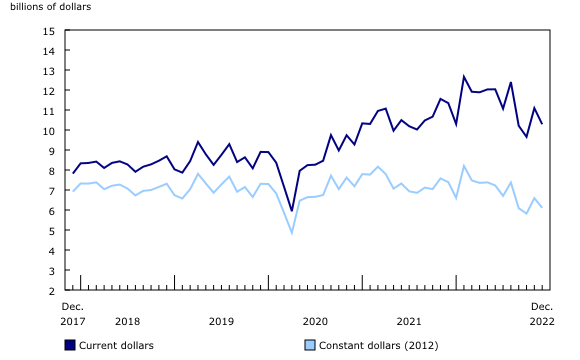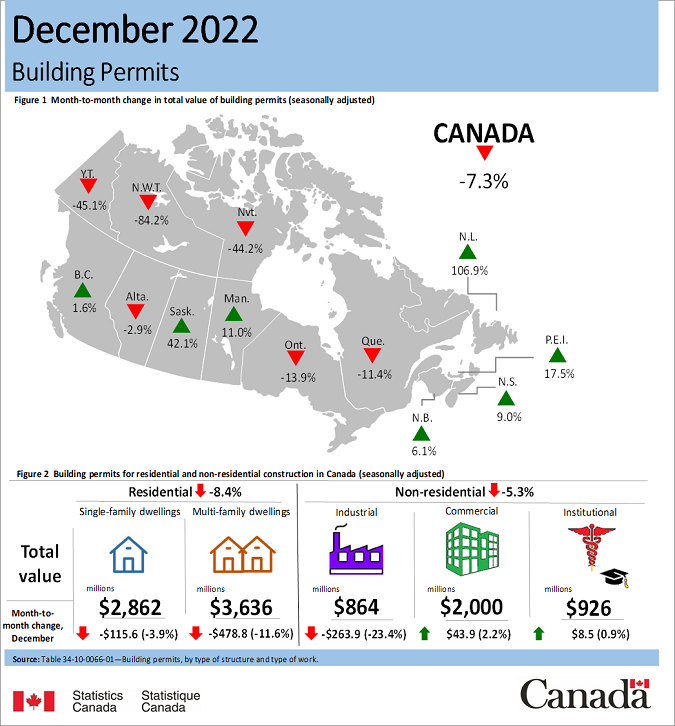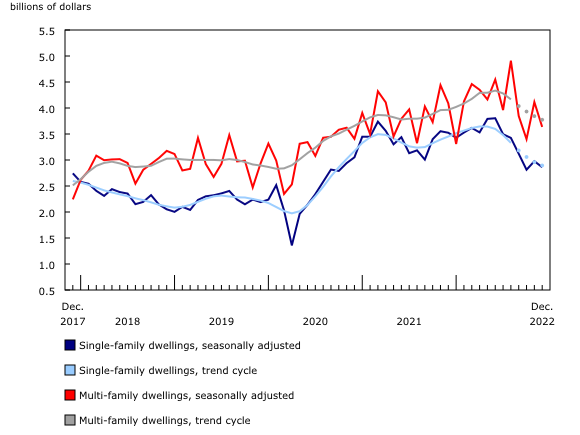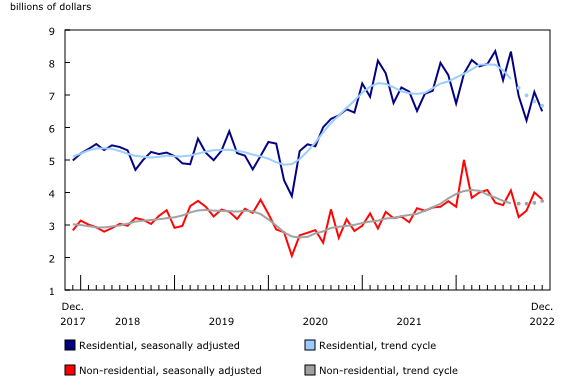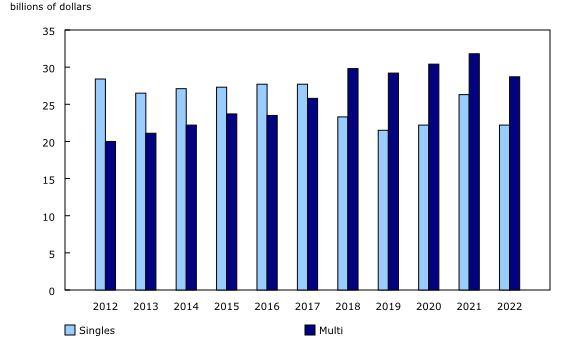Building permits, December 2022
Released: 2023-02-02
$10.3 billion
December 2022
-7.3% 
(monthly change)
$64.2 million
December 2022
106.9% 
(monthly change)
$56.1 million
December 2022
17.5% 
(monthly change)
$210.9 million
December 2022
9.0% 
(monthly change)
$126.8 million
December 2022
6.1% 
(monthly change)
$1,781.0 million
December 2022
-11.4% 
(monthly change)
$4,405.1 million
December 2022
-13.9% 
(monthly change)
$357.4 million
December 2022
11.0% 
(monthly change)
$179.6 million
December 2022
42.1% 
(monthly change)
$1,167.2 million
December 2022
-2.9% 
(monthly change)
$1,929.5 million
December 2022
1.6% 
(monthly change)
$7.5 million
December 2022
-45.1% 
(monthly change)
$1.4 million
December 2022
-84.2% 
(monthly change)
$0.7 million
December 2022
-44.2% 
(monthly change)
The monthly total seasonally adjusted value of building permits in Canada decreased 7.3% in December to $10.3 billion. Declines were posted in both the residential and the non-residential sectors.
On a constant dollar basis (2012=100), the total value of building permits fell 7.4% to $6.1 billion.
Residential sector down in December following a strong November
The total value of residential permits declined 8.4% to $6.5 billion in December.
Construction intentions in the single-family homes component decreased 3.9% while multi-family permit values fell 11.6%, with seven provinces posting declines. Quebec (-43.4%) contributed to much of the decline in the multi-family component following a strong November. Conversely, notable gains were posted in New Brunswick (+46.4%) and Saskatchewan (+36.9%) in December.
Ontario drags down non-residential sector
The total value of non-residential permits declined 5.3% to $3.8 billion in December. Decreases posted in Ontario more than offset gains posted in seven provinces.
Construction intentions in the industrial sector decreased 23.4% in December, following a record high in November.
In December, the value of commercial permits edged up 2.2%, with seven provinces posting increases. Alberta led the way with a variety of large permits in Calgary.
The total value of institutional building permits posted a modest growth month over month (+0.9%). Large losses in Ontario (-30.1%) were offset by notable gains in Quebec (+45.1%), Manitoba (+228.6%) and Saskatchewan (+333.8%). The superlative results in the latter two provinces were driven by building permits for new hospital construction.
Fourth quarter construction intentions continue to slow
The total value of building permits in the fourth quarter of 2022 decreased 7.8% from the previous quarter to $31.0 billion.
The residential sector decreased for the second consecutive quarter in the fourth quarter after a year of multiple interest rate hikes. Rising interest rates impact construction intentions, as they increase the costs for new projects and can make it more difficult for developers and buyers to secure financing. Construction intentions fell 13.0% to $19.8 billion in the quarter, with declines posted in all provinces except Newfoundland and Labrador. Single-family permits decreased 13.8%, while multi-family permits dropped 12.3%.
The non-residential sector increased by 2.9% to $11.2 billion, led by the industrial component, which sharply increased by 29.5% to a record quarterly high ($2.8 billion). Commercial permit values remained relatively stable (+0.3%), while institutional permit values fell by 12.3% for a third consecutive quarterly decrease.
Annual review of 2022: trending decline for building permits of single-family homes
The total current dollar value of building permits continued to climb to new records, increasing 6.8% in 2022. However, the annual increase was largely the result of inflated valuations from persistent material and labour cost increases. On a constant dollar basis (2012=100), the total value of building permits declined 6.6% to $83.0 billion.
The remainder of the article will be presented in constant dollars to eliminate the impact of changes in purchasing power of the dollar over time.
After three consecutive yearly increases, construction intentions in the residential sector declined 12.3% to $50.9 billion. Decreases in the value of single-family permits (-15.5%) outpaced the decline in multi-family permits (-9.6%) in 2022.
The amount and mix of residential permits for single and multi-family homes can be attributed to a multitude of supply and demand factors, such as shifting household characteristics and preferences, changing construction regulations, and the price of single and multi-family homes. Chart 4 shows that over time, residential construction intentions have shifted away from single-family buildings, which composed of 58.8% of the value of residential building permits 10 years earlier compared with 43.6% in 2022. This translated to 84,000 units ($28.4 billion) being issued for single-family homes in 2012 compared with 72,000 new single-family units in 2022 ($22.2 billion), despite a population increase of over four million people over the same period.
The non-residential sector was up 4.1% to $32.0 billion in 2022. Despite a second consecutive yearly increase, the sector remains below pre-COVID-19 pandemic levels ($34.6 billion in 2019). Much of the increase was due to the industrial component, which sharply increased by 20.1%. This was led by 10 industrial permits valued over $100 million throughout the year, including a $425 million permit in November for a manufacturing facility in Toronto.
Despite the largest building permit of the year being worth almost $1.5 billion for a new hospital in Vancouver, the institutional component advanced 3.0%. The commercial component posted a marginal decline of 0.7% on an annual basis.
To explore data using an interactive user interface, visit the Building permits: Interactive Dashboard.
To explore the impact of the COVID-19 pandemic on the socioeconomic landscape, please consult the Canadian Economic Dashboard and COVID-19.
For more information on housing, please visit the Housing statistics portal.
Statistics Canada has a Housing Market Indicators dashboard. This web application provides access to key housing market indicators for Canada, by province and by census metropolitan area. The indicators are updated automatically with new information from monthly releases, giving users access to the latest data.
Note to readers
Unless otherwise stated, this release presents seasonally adjusted data with current dollar values, which facilitate month-to-month and quarter-to-quarter comparisons by removing the effects of seasonal variations. For information on seasonal adjustment, see Seasonally adjusted data – Frequently asked questions.
Building components
- Single-family dwellings: Residential buildings containing only one dwelling unit (e.g., single-detached house, bungalow, linked home [linked at the foundation]).
- Multi-family dwellings: Residential buildings containing multiple dwelling units (e.g., apartment, apartment condominium, row house, semi-detached house).
- Industrial buildings: Buildings used in the processing or production of goods or related to transportation and communication.
- Commercial buildings: Buildings used in the trade or distribution of goods and services, including office buildings.
- Institutional and government buildings: Buildings used to house public and semi-public services, such as those related to health and welfare, education or public administration, and buildings used for religious services.
Revision
Data are subject to revisions based on late responses, methodological changes and classification updates. Unadjusted data has been revised for the previous month. Seasonally adjusted data has been revised for the previous three months.
For information on trend-cycle data, see the StatCan Blog and Trend-cycle estimates – Frequently asked questions.
Next release
Data on building permits for January will be released on March 3, 2023.
Contact information
For more information, or to enquire about the concepts, methods or data quality of this release, contact us (toll-free 1-800-263-1136; 514-283-8300; infostats@statcan.gc.ca) or Media Relations (statcan.mediahotline-ligneinfomedias.statcan@statcan.gc.ca).
- Date modified:

